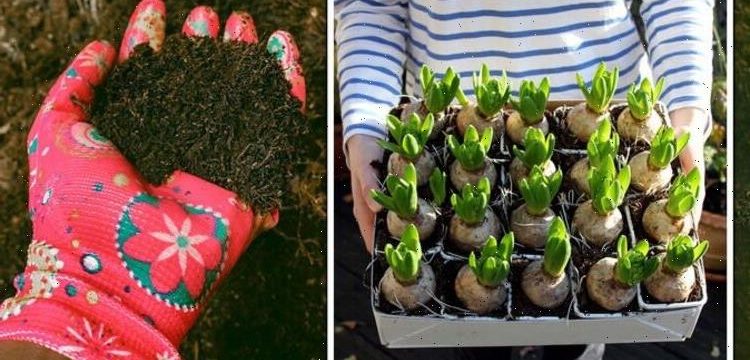Gardening: Expert demonstrates how to deadhead flowers
We use your sign-up to provide content in ways you’ve consented to and to improve our understanding of you. This may include adverts from us and 3rd parties based on our understanding. You can unsubscribe at any time. More info
Planting summer flowering bulbs is a crucial gardening task during spring, with plenty of tender varieties ready to be dug into your garden soil. Dahlias, gladioli and bright begonias make for the perfect addition to your summer flower display, but they’re only as good as the soil they’re planted in. With a wide range of soil types to choose from, these are the best mixes to use for your summer bulbs.
Growing plants from bulbs is often quicker and easier than raising young seedlings, but choosing the right soil is even more important to help your plant thrive.
While almost all bulbs require well-drained and aerated soil, there are a number of natural ingredients which provide an added boost to the quality of your planting site.
Grit, manure and organic matter can all be beneficial for growing bulbs, but which mixes are best-suited to summer flowers?


What are the best soil mixes for summer bulbs?
Whether you’re potting your summer bulbs or adding them to a border display, well-draining soil is essential for healthy growth.
However, choosing the right “extras” for your soil will depend on the planting site, so it is important to tailor your compost or soil mix to the environment in which your bulbs will grow.
Soil mix for pots and containers
Summer flowers are a sight to behold during their flowering season – especially when they are grown in large pots.
Coarse materials are perfect for potted summer bulbs, but which mixes should you use?

Heavily gritted soil mix
For large pots (around 2.5 feet deep) make use of solid, gritty materials to enrich your soil.
Adding these hard-wearing materials to your pots will provide extra drainage and encourage sustainable growth without the risk of rot.
Gritty materials work by opening up the soil structure and improving the texture of the earth around the growing roots.
To make your own coarse soil mix, break up old bricks and gather gritty ingredients such as turface, granite and pine bark.
DON’T MISS:
March gardening: Five timely tasks to do in the garden this weekend [REVEAL]
Monty Don shares the ‘one rule’ to follow when pruning the garden [INSIGHT]
When to cut back fuchsia – spring pruning tips [LATEST]

Start by filling the base of the pot with shattered brick fragments and then top with your soil mix.
To make the soil mix, you should combine four parts multi-purpose coarse compost with one part of your chosen “gritty” material.
For smaller pots, you can reduce the quantities to around two inches worth of grit at the base, with three parts compost and one part grit.
For extra draining in closed pots, you can add a few holes to the base before planting your bulbs.

Soil mix for beds and borders
Unlike pots, there is more free drainage for bulbs grown in garden beds and borders.
This means that less grit and more fibrous materials are favoured for open soil beds.
Organic matter such as manure and fruit or vegetable peelings are favourable, so be sure to keep adding to your compost heap before planting out your summer bulbs.
Green and brown soil mix
For the best bedding compost, mix “greens” and “browns” from your compost heap.
“Greens” are considered to be fresh materials, rich in nitrogen while “browns” are drier materials, rich in carbon.
Add equal parts of “green and brown” compost to your gritty soil mix before planting your bulbs.
Lightly gritted soil mix
In beds or borders with heavy soil, you should increase drainage with gritty materials.
Clay soils are notorious for retaining moisture, which can challenge the growth of bulbs through spring when rainfall is a regular occurrence.
Before planting your summer bulbs, dig out the soil and mix it with one part compost and one part horticultural grit.
Plant your bulbs as normal, leaving a good few inches of the soil mix beneath the bulbs.
Source: Read Full Article
